ICT707 Data Science: Exploring PySpark for Data Science Applications
VerifiedAdded on 2022/10/17
|13
|1910
|10
Report
AI Summary
This report delves into the practical application of PySpark in data science, focusing on key concepts such as machine learning pipelines, collaborative filtering, logistic regression, and K-means clustering. The introduction highlights the significance of data science and the role of PySpark as a powerful tool for handling large-scale data processing. The report explores the Apache Spark system, RDDs, DataFrames, and MLlib, providing a foundation for understanding the core components. Machine learning pipelines, including Transformers, Estimators, and DataFrames, are discussed in detail, along with their practical applications. The report then examines collaborative filtering for building recommendation engine systems, using the ALS method, and presents the model building process and prediction results. Logistic regression, a supervised learning model, is explained, and its implementation with RDD-based Logistic RegressionWithLBFGS is demonstrated. Finally, K-means clustering, an unsupervised learning model, is explored, including its application, model evaluation, and accuracy assessment. The conclusion summarizes the key insights gained from using PySpark in real-life data science problems. References to relevant sources are also provided.

DATA SCIENCE PRACTICES
USING PYSPARK
Report’s Author:
USING PYSPARK
Report’s Author:
Paraphrase This Document
Need a fresh take? Get an instant paraphrase of this document with our AI Paraphraser
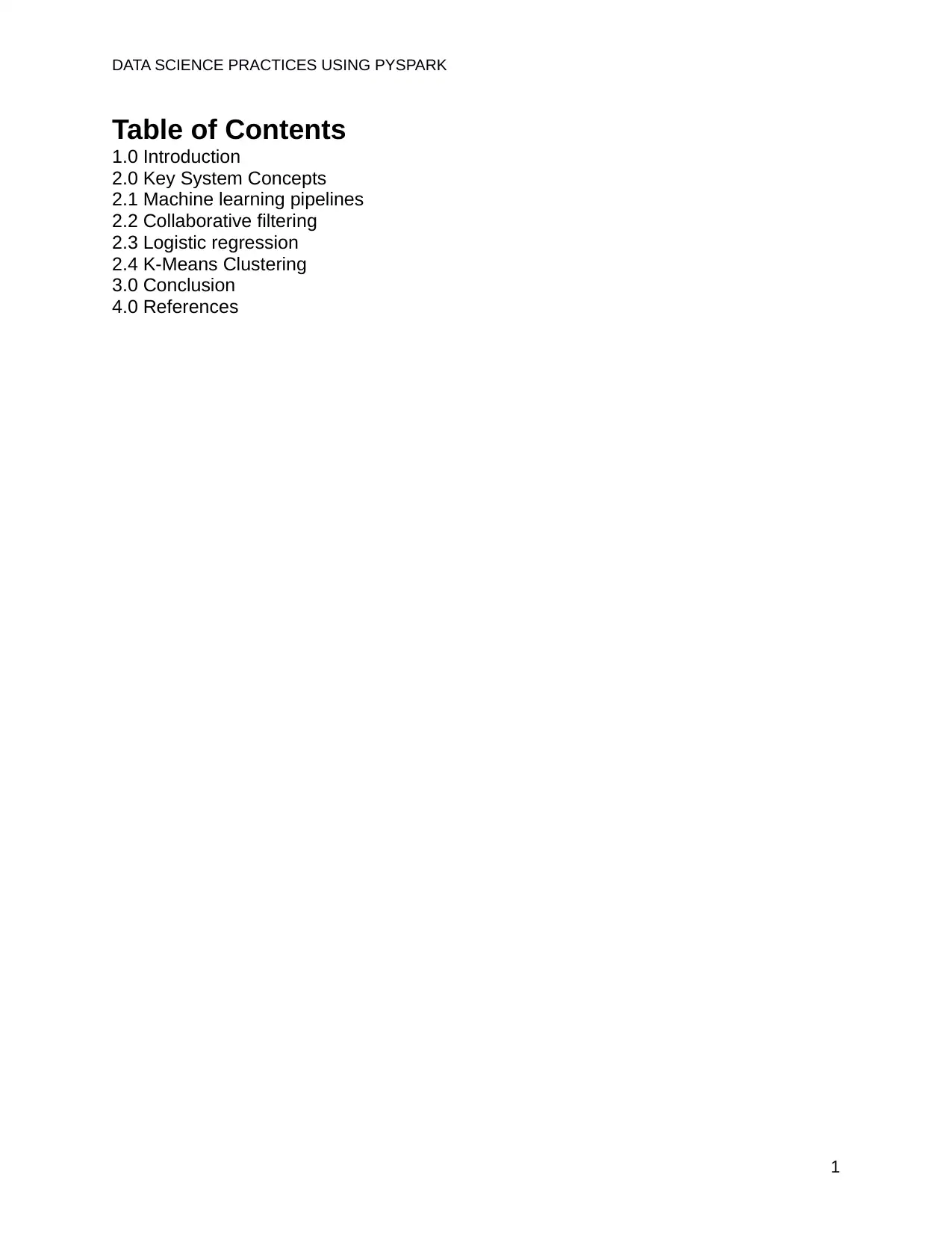
DATA SCIENCE PRACTICES USING PYSPARK
Table of Contents
1.0 Introduction
2.0 Key System Concepts
2.1 Machine learning pipelines
2.2 Collaborative filtering
2.3 Logistic regression
2.4 K-Means Clustering
3.0 Conclusion
4.0 References
1
Table of Contents
1.0 Introduction
2.0 Key System Concepts
2.1 Machine learning pipelines
2.2 Collaborative filtering
2.3 Logistic regression
2.4 K-Means Clustering
3.0 Conclusion
4.0 References
1
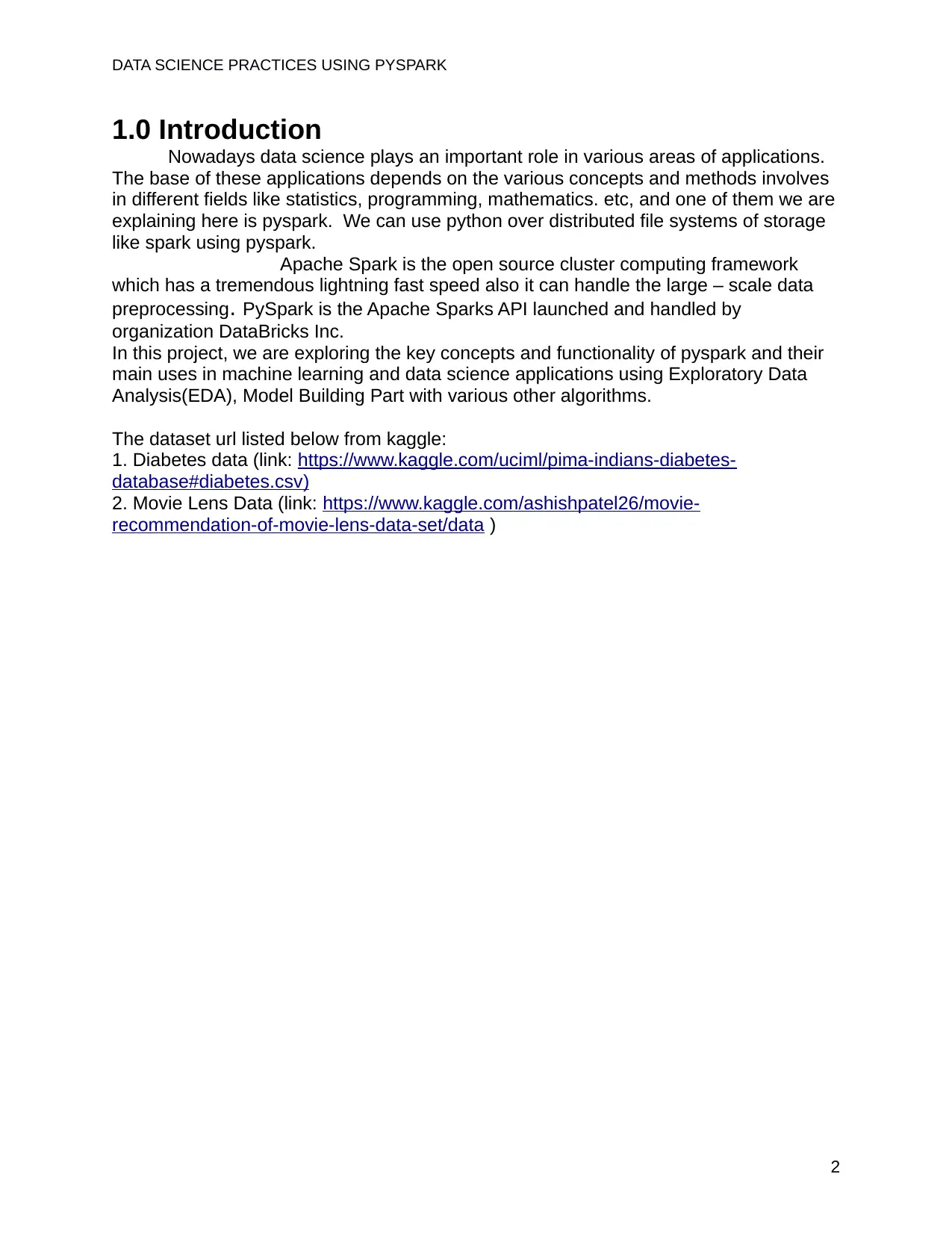
DATA SCIENCE PRACTICES USING PYSPARK
1.0 Introduction
Nowadays data science plays an important role in various areas of applications.
The base of these applications depends on the various concepts and methods involves
in different fields like statistics, programming, mathematics. etc, and one of them we are
explaining here is pyspark. We can use python over distributed file systems of storage
like spark using pyspark.
Apache Spark is the open source cluster computing framework
which has a tremendous lightning fast speed also it can handle the large – scale data
preprocessing. PySpark is the Apache Sparks API launched and handled by
organization DataBricks Inc.
In this project, we are exploring the key concepts and functionality of pyspark and their
main uses in machine learning and data science applications using Exploratory Data
Analysis(EDA), Model Building Part with various other algorithms.
The dataset url listed below from kaggle:
1. Diabetes data (link: https://www.kaggle.com/uciml/pima-indians-diabetes-
database#diabetes.csv)
2. Movie Lens Data (link: https://www.kaggle.com/ashishpatel26/movie-
recommendation-of-movie-lens-data-set/data )
2
1.0 Introduction
Nowadays data science plays an important role in various areas of applications.
The base of these applications depends on the various concepts and methods involves
in different fields like statistics, programming, mathematics. etc, and one of them we are
explaining here is pyspark. We can use python over distributed file systems of storage
like spark using pyspark.
Apache Spark is the open source cluster computing framework
which has a tremendous lightning fast speed also it can handle the large – scale data
preprocessing. PySpark is the Apache Sparks API launched and handled by
organization DataBricks Inc.
In this project, we are exploring the key concepts and functionality of pyspark and their
main uses in machine learning and data science applications using Exploratory Data
Analysis(EDA), Model Building Part with various other algorithms.
The dataset url listed below from kaggle:
1. Diabetes data (link: https://www.kaggle.com/uciml/pima-indians-diabetes-
database#diabetes.csv)
2. Movie Lens Data (link: https://www.kaggle.com/ashishpatel26/movie-
recommendation-of-movie-lens-data-set/data )
2
⊘ This is a preview!⊘
Do you want full access?
Subscribe today to unlock all pages.

Trusted by 1+ million students worldwide
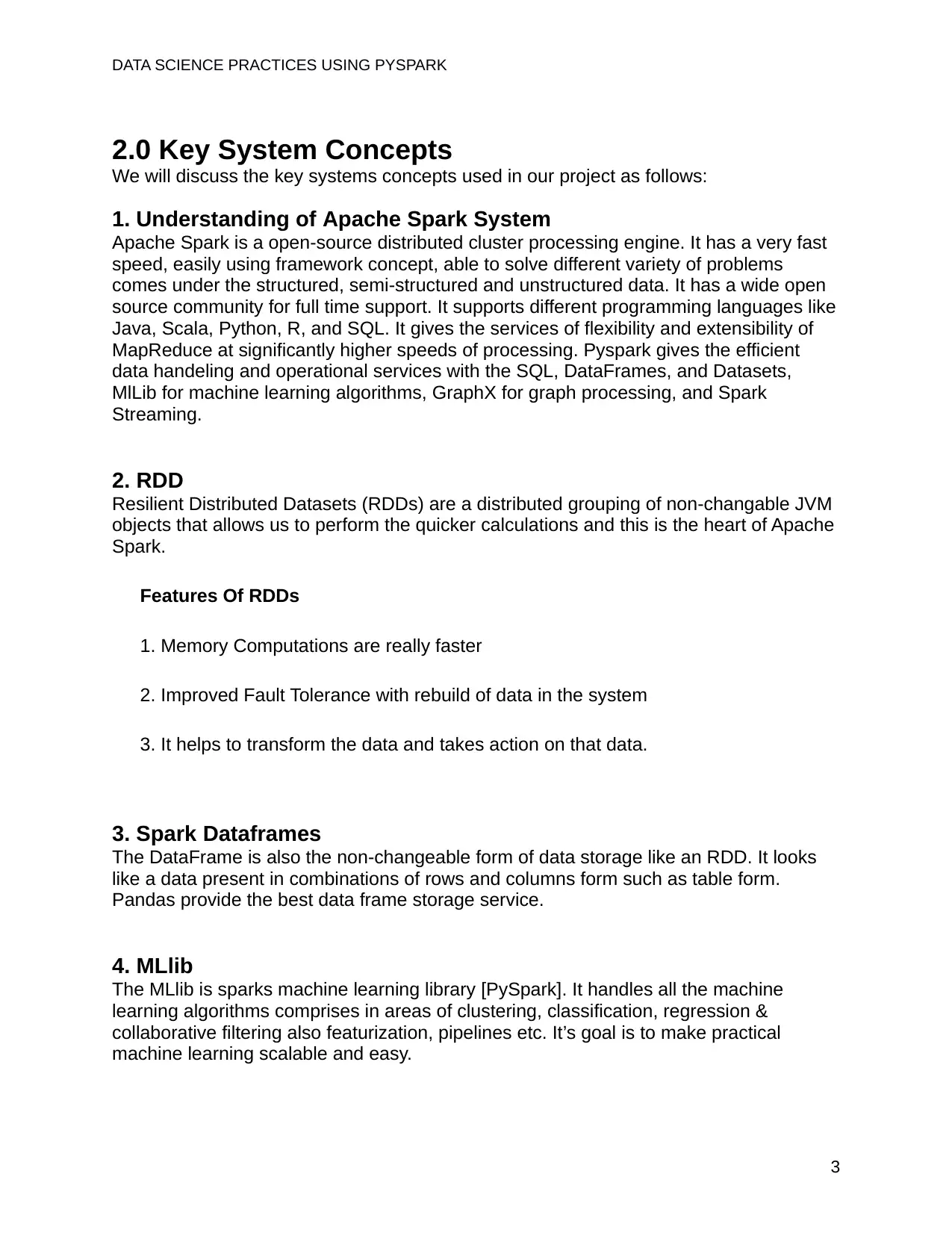
DATA SCIENCE PRACTICES USING PYSPARK
2.0 Key System Concepts
We will discuss the key systems concepts used in our project as follows:
1. Understanding of Apache Spark System
Apache Spark is a open-source distributed cluster processing engine. It has a very fast
speed, easily using framework concept, able to solve different variety of problems
comes under the structured, semi-structured and unstructured data. It has a wide open
source community for full time support. It supports different programming languages like
Java, Scala, Python, R, and SQL. It gives the services of flexibility and extensibility of
MapReduce at significantly higher speeds of processing. Pyspark gives the efficient
data handeling and operational services with the SQL, DataFrames, and Datasets,
MlLib for machine learning algorithms, GraphX for graph processing, and Spark
Streaming.
2. RDD
Resilient Distributed Datasets (RDDs) are a distributed grouping of non-changable JVM
objects that allows us to perform the quicker calculations and this is the heart of Apache
Spark.
Features Of RDDs
1. Memory Computations are really faster
2. Improved Fault Tolerance with rebuild of data in the system
3. It helps to transform the data and takes action on that data.
3. Spark Dataframes
The DataFrame is also the non-changeable form of data storage like an RDD. It looks
like a data present in combinations of rows and columns form such as table form.
Pandas provide the best data frame storage service.
4. MLlib
The MLlib is sparks machine learning library [PySpark]. It handles all the machine
learning algorithms comprises in areas of clustering, classification, regression &
collaborative filtering also featurization, pipelines etc. It’s goal is to make practical
machine learning scalable and easy.
3
2.0 Key System Concepts
We will discuss the key systems concepts used in our project as follows:
1. Understanding of Apache Spark System
Apache Spark is a open-source distributed cluster processing engine. It has a very fast
speed, easily using framework concept, able to solve different variety of problems
comes under the structured, semi-structured and unstructured data. It has a wide open
source community for full time support. It supports different programming languages like
Java, Scala, Python, R, and SQL. It gives the services of flexibility and extensibility of
MapReduce at significantly higher speeds of processing. Pyspark gives the efficient
data handeling and operational services with the SQL, DataFrames, and Datasets,
MlLib for machine learning algorithms, GraphX for graph processing, and Spark
Streaming.
2. RDD
Resilient Distributed Datasets (RDDs) are a distributed grouping of non-changable JVM
objects that allows us to perform the quicker calculations and this is the heart of Apache
Spark.
Features Of RDDs
1. Memory Computations are really faster
2. Improved Fault Tolerance with rebuild of data in the system
3. It helps to transform the data and takes action on that data.
3. Spark Dataframes
The DataFrame is also the non-changeable form of data storage like an RDD. It looks
like a data present in combinations of rows and columns form such as table form.
Pandas provide the best data frame storage service.
4. MLlib
The MLlib is sparks machine learning library [PySpark]. It handles all the machine
learning algorithms comprises in areas of clustering, classification, regression &
collaborative filtering also featurization, pipelines etc. It’s goal is to make practical
machine learning scalable and easy.
3
Paraphrase This Document
Need a fresh take? Get an instant paraphrase of this document with our AI Paraphraser
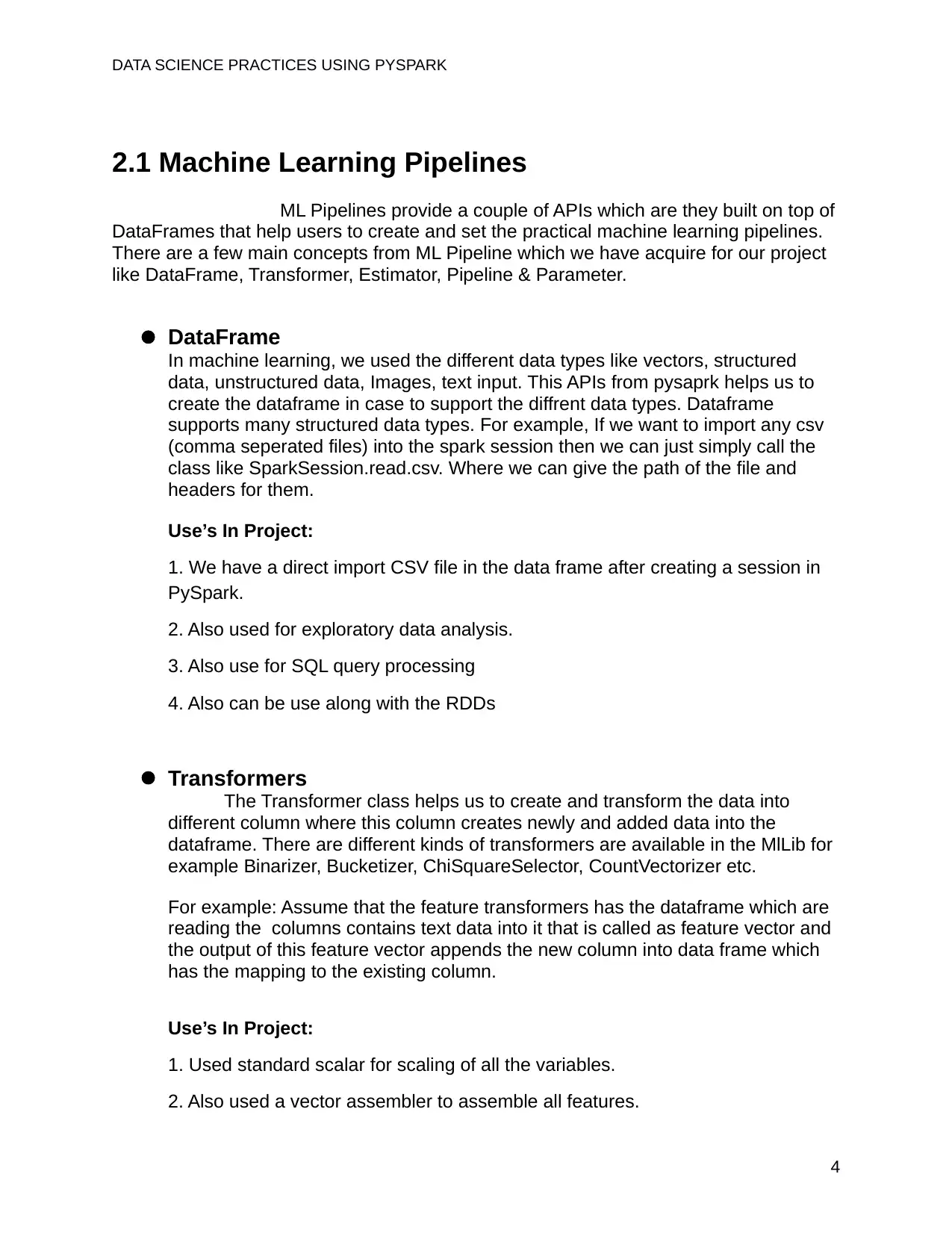
DATA SCIENCE PRACTICES USING PYSPARK
2.1 Machine Learning Pipelines
ML Pipelines provide a couple of APIs which are they built on top of
DataFrames that help users to create and set the practical machine learning pipelines.
There are a few main concepts from ML Pipeline which we have acquire for our project
like DataFrame, Transformer, Estimator, Pipeline & Parameter.
l DataFrame
In machine learning, we used the different data types like vectors, structured
data, unstructured data, Images, text input. This APIs from pysaprk helps us to
create the dataframe in case to support the diffrent data types. Dataframe
supports many structured data types. For example, If we want to import any csv
(comma seperated files) into the spark session then we can just simply call the
class like SparkSession.read.csv. Where we can give the path of the file and
headers for them.
Use’s In Project:
1. We have a direct import CSV file in the data frame after creating a session in
PySpark.
2. Also used for exploratory data analysis.
3. Also use for SQL query processing
4. Also can be use along with the RDDs
l Transformers
The Transformer class helps us to create and transform the data into
different column where this column creates newly and added data into the
dataframe. There are different kinds of transformers are available in the MlLib for
example Binarizer, Bucketizer, ChiSquareSelector, CountVectorizer etc.
For example: Assume that the feature transformers has the dataframe which are
reading the columns contains text data into it that is called as feature vector and
the output of this feature vector appends the new column into data frame which
has the mapping to the existing column.
Use’s In Project:
1. Used standard scalar for scaling of all the variables.
2. Also used a vector assembler to assemble all features.
4
2.1 Machine Learning Pipelines
ML Pipelines provide a couple of APIs which are they built on top of
DataFrames that help users to create and set the practical machine learning pipelines.
There are a few main concepts from ML Pipeline which we have acquire for our project
like DataFrame, Transformer, Estimator, Pipeline & Parameter.
l DataFrame
In machine learning, we used the different data types like vectors, structured
data, unstructured data, Images, text input. This APIs from pysaprk helps us to
create the dataframe in case to support the diffrent data types. Dataframe
supports many structured data types. For example, If we want to import any csv
(comma seperated files) into the spark session then we can just simply call the
class like SparkSession.read.csv. Where we can give the path of the file and
headers for them.
Use’s In Project:
1. We have a direct import CSV file in the data frame after creating a session in
PySpark.
2. Also used for exploratory data analysis.
3. Also use for SQL query processing
4. Also can be use along with the RDDs
l Transformers
The Transformer class helps us to create and transform the data into
different column where this column creates newly and added data into the
dataframe. There are different kinds of transformers are available in the MlLib for
example Binarizer, Bucketizer, ChiSquareSelector, CountVectorizer etc.
For example: Assume that the feature transformers has the dataframe which are
reading the columns contains text data into it that is called as feature vector and
the output of this feature vector appends the new column into data frame which
has the mapping to the existing column.
Use’s In Project:
1. Used standard scalar for scaling of all the variables.
2. Also used a vector assembler to assemble all features.
4

DATA SCIENCE PRACTICES USING PYSPARK
l Estimators
Estimators are always be the statistical model where it can be used to measure
the performace of the created model of predictions or classifications. Generally,
estimators uses the method called fit() for fitting of the model where it can openly
accepts the dataframes and generates the model. For example, the clustering
model called KMeans is devotes as the estimator and after using fit() that helps
us to train the KMeans() model.
Use’s In Project:
1. Used this concept while building a model for K-means and for Logistic
Regression.
5
l Estimators
Estimators are always be the statistical model where it can be used to measure
the performace of the created model of predictions or classifications. Generally,
estimators uses the method called fit() for fitting of the model where it can openly
accepts the dataframes and generates the model. For example, the clustering
model called KMeans is devotes as the estimator and after using fit() that helps
us to train the KMeans() model.
Use’s In Project:
1. Used this concept while building a model for K-means and for Logistic
Regression.
5
⊘ This is a preview!⊘
Do you want full access?
Subscribe today to unlock all pages.

Trusted by 1+ million students worldwide
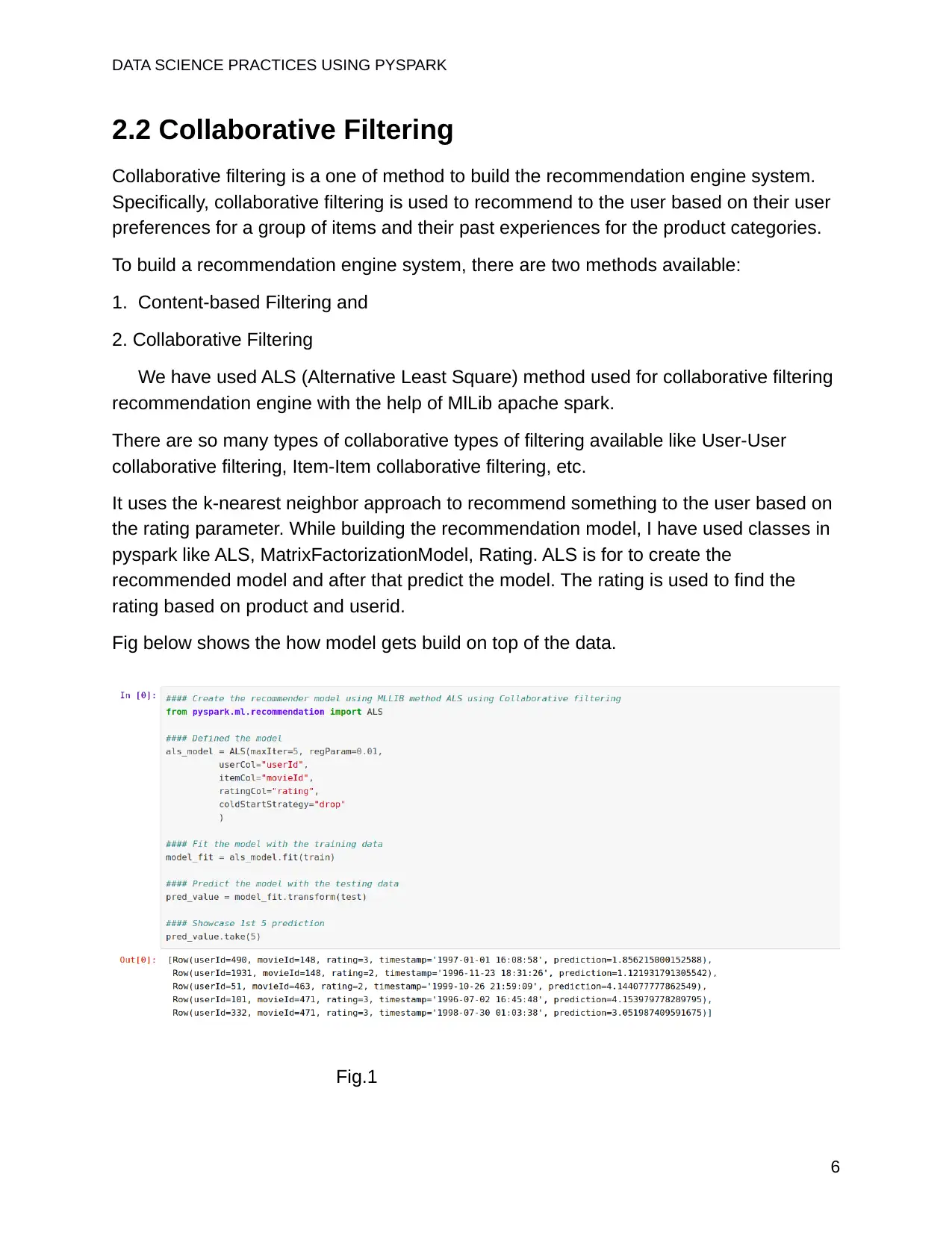
DATA SCIENCE PRACTICES USING PYSPARK
2.2 Collaborative Filtering
Collaborative filtering is a one of method to build the recommendation engine system.
Specifically, collaborative filtering is used to recommend to the user based on their user
preferences for a group of items and their past experiences for the product categories.
To build a recommendation engine system, there are two methods available:
1. Content-based Filtering and
2. Collaborative Filtering
We have used ALS (Alternative Least Square) method used for collaborative filtering
recommendation engine with the help of MlLib apache spark.
There are so many types of collaborative types of filtering available like User-User
collaborative filtering, Item-Item collaborative filtering, etc.
It uses the k-nearest neighbor approach to recommend something to the user based on
the rating parameter. While building the recommendation model, I have used classes in
pyspark like ALS, MatrixFactorizationModel, Rating. ALS is for to create the
recommended model and after that predict the model. The rating is used to find the
rating based on product and userid.
Fig below shows the how model gets build on top of the data.
Fig.1
6
2.2 Collaborative Filtering
Collaborative filtering is a one of method to build the recommendation engine system.
Specifically, collaborative filtering is used to recommend to the user based on their user
preferences for a group of items and their past experiences for the product categories.
To build a recommendation engine system, there are two methods available:
1. Content-based Filtering and
2. Collaborative Filtering
We have used ALS (Alternative Least Square) method used for collaborative filtering
recommendation engine with the help of MlLib apache spark.
There are so many types of collaborative types of filtering available like User-User
collaborative filtering, Item-Item collaborative filtering, etc.
It uses the k-nearest neighbor approach to recommend something to the user based on
the rating parameter. While building the recommendation model, I have used classes in
pyspark like ALS, MatrixFactorizationModel, Rating. ALS is for to create the
recommended model and after that predict the model. The rating is used to find the
rating based on product and userid.
Fig below shows the how model gets build on top of the data.
Fig.1
6
Paraphrase This Document
Need a fresh take? Get an instant paraphrase of this document with our AI Paraphraser
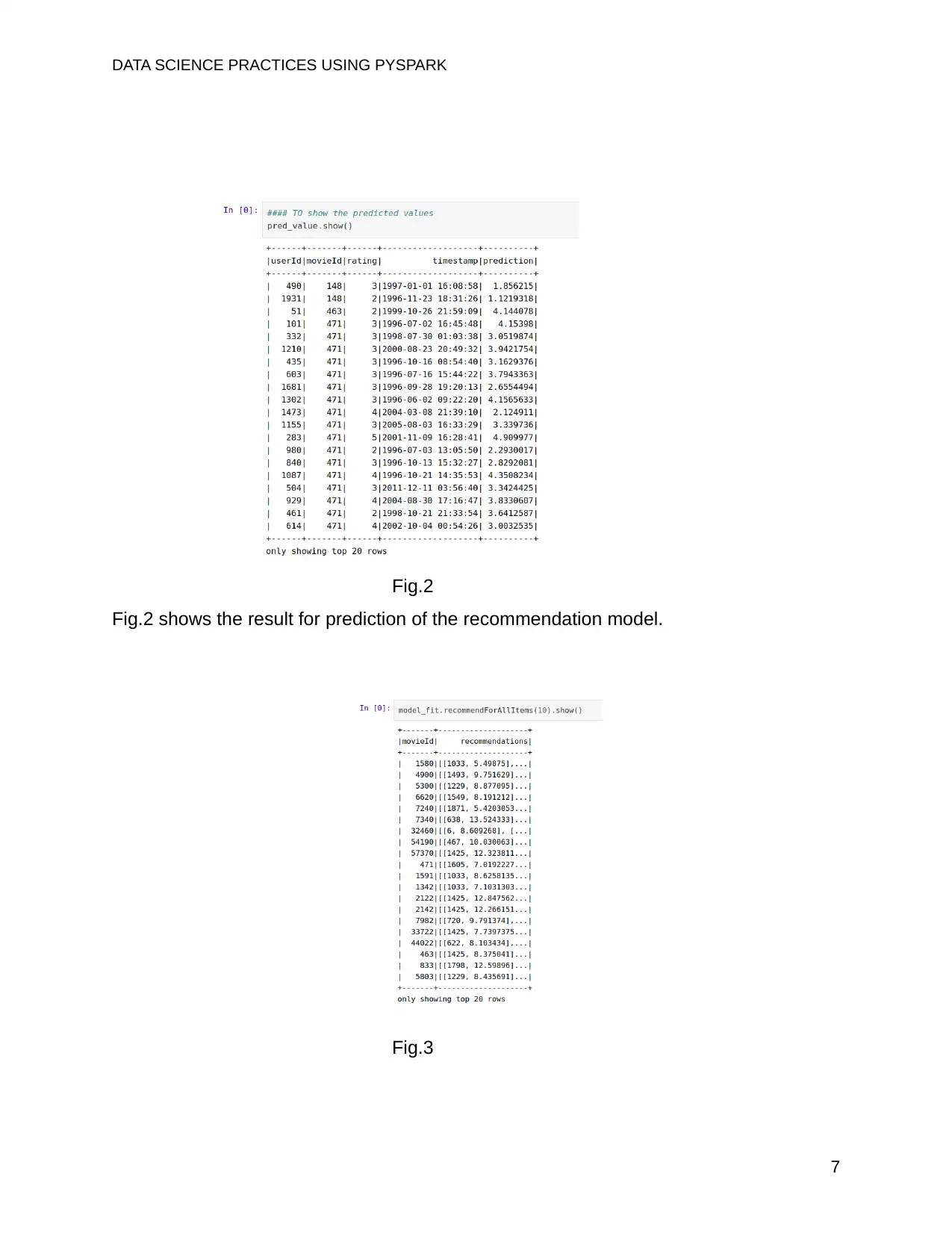
DATA SCIENCE PRACTICES USING PYSPARK
Fig.2
Fig.2 shows the result for prediction of the recommendation model.
Fig.3
7
Fig.2
Fig.2 shows the result for prediction of the recommendation model.
Fig.3
7
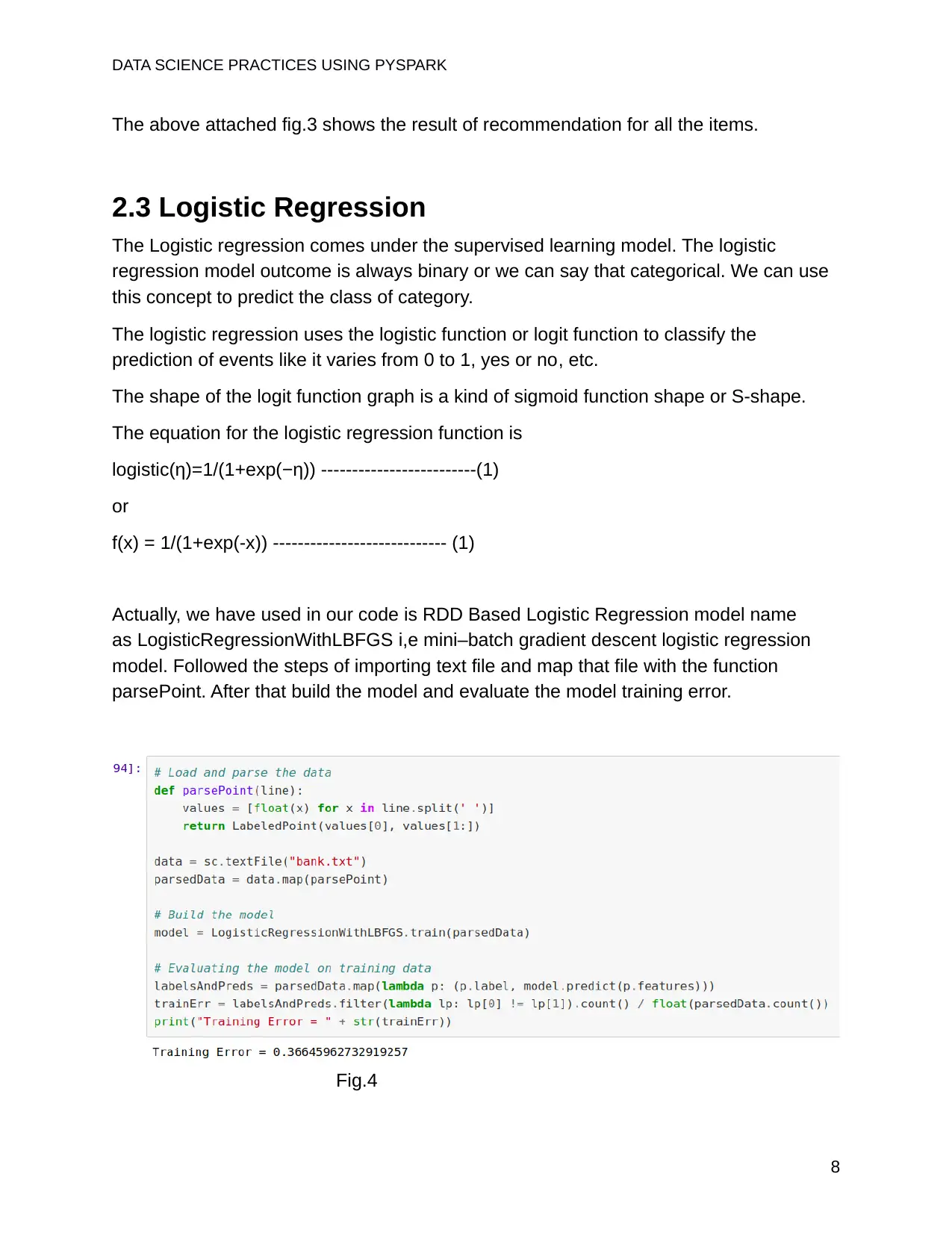
DATA SCIENCE PRACTICES USING PYSPARK
The above attached fig.3 shows the result of recommendation for all the items.
2.3 Logistic Regression
The Logistic regression comes under the supervised learning model. The logistic
regression model outcome is always binary or we can say that categorical. We can use
this concept to predict the class of category.
The logistic regression uses the logistic function or logit function to classify the
prediction of events like it varies from 0 to 1, yes or no, etc.
The shape of the logit function graph is a kind of sigmoid function shape or S-shape.
The equation for the logistic regression function is
logistic(η)=1/(1+exp(−η)) -------------------------(1)
or
f(x) = 1/(1+exp(-x)) ---------------------------- (1)
Actually, we have used in our code is RDD Based Logistic Regression model name
as LogisticRegressionWithLBFGS i,e mini–batch gradient descent logistic regression
model. Followed the steps of importing text file and map that file with the function
parsePoint. After that build the model and evaluate the model training error.
Fig.4
8
The above attached fig.3 shows the result of recommendation for all the items.
2.3 Logistic Regression
The Logistic regression comes under the supervised learning model. The logistic
regression model outcome is always binary or we can say that categorical. We can use
this concept to predict the class of category.
The logistic regression uses the logistic function or logit function to classify the
prediction of events like it varies from 0 to 1, yes or no, etc.
The shape of the logit function graph is a kind of sigmoid function shape or S-shape.
The equation for the logistic regression function is
logistic(η)=1/(1+exp(−η)) -------------------------(1)
or
f(x) = 1/(1+exp(-x)) ---------------------------- (1)
Actually, we have used in our code is RDD Based Logistic Regression model name
as LogisticRegressionWithLBFGS i,e mini–batch gradient descent logistic regression
model. Followed the steps of importing text file and map that file with the function
parsePoint. After that build the model and evaluate the model training error.
Fig.4
8
⊘ This is a preview!⊘
Do you want full access?
Subscribe today to unlock all pages.

Trusted by 1+ million students worldwide
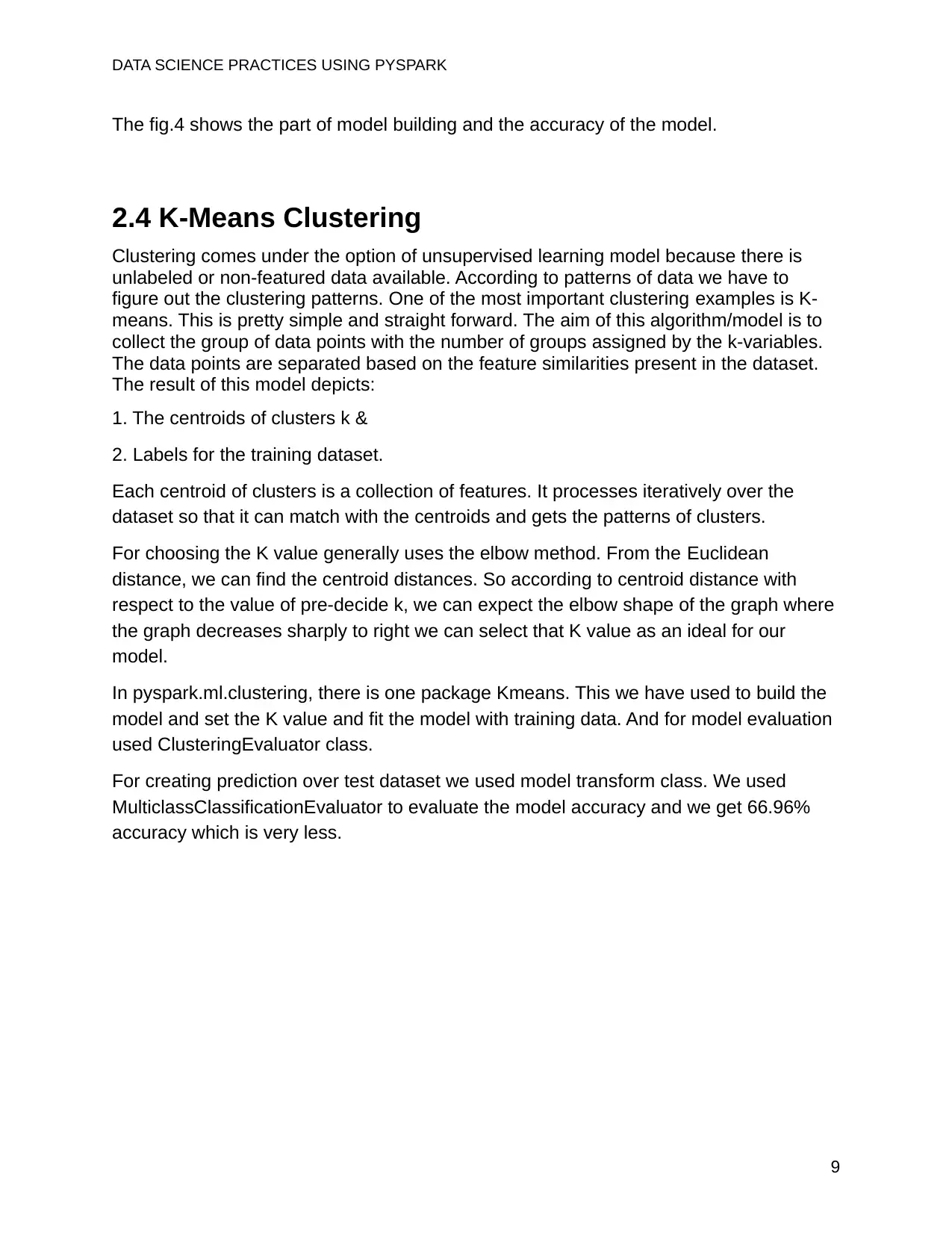
DATA SCIENCE PRACTICES USING PYSPARK
The fig.4 shows the part of model building and the accuracy of the model.
2.4 K-Means Clustering
Clustering comes under the option of unsupervised learning model because there is
unlabeled or non-featured data available. According to patterns of data we have to
figure out the clustering patterns. One of the most important clustering examples is K-
means. This is pretty simple and straight forward. The aim of this algorithm/model is to
collect the group of data points with the number of groups assigned by the k-variables.
The data points are separated based on the feature similarities present in the dataset.
The result of this model depicts:
1. The centroids of clusters k &
2. Labels for the training dataset.
Each centroid of clusters is a collection of features. It processes iteratively over the
dataset so that it can match with the centroids and gets the patterns of clusters.
For choosing the K value generally uses the elbow method. From the Euclidean
distance, we can find the centroid distances. So according to centroid distance with
respect to the value of pre-decide k, we can expect the elbow shape of the graph where
the graph decreases sharply to right we can select that K value as an ideal for our
model.
In pyspark.ml.clustering, there is one package Kmeans. This we have used to build the
model and set the K value and fit the model with training data. And for model evaluation
used ClusteringEvaluator class.
For creating prediction over test dataset we used model transform class. We used
MulticlassClassificationEvaluator to evaluate the model accuracy and we get 66.96%
accuracy which is very less.
9
The fig.4 shows the part of model building and the accuracy of the model.
2.4 K-Means Clustering
Clustering comes under the option of unsupervised learning model because there is
unlabeled or non-featured data available. According to patterns of data we have to
figure out the clustering patterns. One of the most important clustering examples is K-
means. This is pretty simple and straight forward. The aim of this algorithm/model is to
collect the group of data points with the number of groups assigned by the k-variables.
The data points are separated based on the feature similarities present in the dataset.
The result of this model depicts:
1. The centroids of clusters k &
2. Labels for the training dataset.
Each centroid of clusters is a collection of features. It processes iteratively over the
dataset so that it can match with the centroids and gets the patterns of clusters.
For choosing the K value generally uses the elbow method. From the Euclidean
distance, we can find the centroid distances. So according to centroid distance with
respect to the value of pre-decide k, we can expect the elbow shape of the graph where
the graph decreases sharply to right we can select that K value as an ideal for our
model.
In pyspark.ml.clustering, there is one package Kmeans. This we have used to build the
model and set the K value and fit the model with training data. And for model evaluation
used ClusteringEvaluator class.
For creating prediction over test dataset we used model transform class. We used
MulticlassClassificationEvaluator to evaluate the model accuracy and we get 66.96%
accuracy which is very less.
9
Paraphrase This Document
Need a fresh take? Get an instant paraphrase of this document with our AI Paraphraser

DATA SCIENCE PRACTICES USING PYSPARK
Fig.5
The above attached figure shows the approach for building the clustering model and its
accuracy.
10
Fig.5
The above attached figure shows the approach for building the clustering model and its
accuracy.
10

DATA SCIENCE PRACTICES USING PYSPARK
3.0 Conclusion
Here we learned the process and how to make more model efficient using PySpark.
Also how spark handles by python and creating clusters of data. Actually, we cover the
main area of a key component of PySpark which is DataFrame, MLlib, and RDD. This
gives us the focused insights that how to use the PySpark in real life problems.
11
3.0 Conclusion
Here we learned the process and how to make more model efficient using PySpark.
Also how spark handles by python and creating clusters of data. Actually, we cover the
main area of a key component of PySpark which is DataFrame, MLlib, and RDD. This
gives us the focused insights that how to use the PySpark in real life problems.
11
⊘ This is a preview!⊘
Do you want full access?
Subscribe today to unlock all pages.

Trusted by 1+ million students worldwide
1 out of 13
Related Documents
Your All-in-One AI-Powered Toolkit for Academic Success.
+13062052269
info@desklib.com
Available 24*7 on WhatsApp / Email
![[object Object]](/_next/static/media/star-bottom.7253800d.svg)
Unlock your academic potential
Copyright © 2020–2025 A2Z Services. All Rights Reserved. Developed and managed by ZUCOL.



